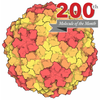[English] 日本語
 Yorodumi
Yorodumi- PDB-9mxc: Cryo-EM Structure of Human Enterovirus D68 USA/IL/14-18952 in Com... -
+ Open data
Open data
- Basic information
Basic information
| Entry | Database: PDB / ID: 9mxc | ||||||||||||||||||||||||
|---|---|---|---|---|---|---|---|---|---|---|---|---|---|---|---|---|---|---|---|---|---|---|---|---|---|
| Title | Cryo-EM Structure of Human Enterovirus D68 USA/IL/14-18952 in Complex with Fc-MFSD6(L3) | ||||||||||||||||||||||||
 Components Components |
| ||||||||||||||||||||||||
 Keywords Keywords | VIRUS / Glycan / MFSD6 / Receptor | ||||||||||||||||||||||||
| Function / homology |  Function and homology information Function and homology informationsymbiont-mediated suppression of cytoplasmic pattern recognition receptor signaling pathway / antigen processing and presentation of exogenous peptide antigen via MHC class I / symbiont-mediated suppression of host cytoplasmic pattern recognition receptor signaling pathway via inhibition of MDA-5 activity / protein sequestering activity / picornain 2A / symbiont-mediated suppression of host mRNA export from nucleus / symbiont genome entry into host cell via pore formation in plasma membrane / picornain 3C / T=pseudo3 icosahedral viral capsid / ribonucleoside triphosphate phosphatase activity ...symbiont-mediated suppression of cytoplasmic pattern recognition receptor signaling pathway / antigen processing and presentation of exogenous peptide antigen via MHC class I / symbiont-mediated suppression of host cytoplasmic pattern recognition receptor signaling pathway via inhibition of MDA-5 activity / protein sequestering activity / picornain 2A / symbiont-mediated suppression of host mRNA export from nucleus / symbiont genome entry into host cell via pore formation in plasma membrane / picornain 3C / T=pseudo3 icosahedral viral capsid / ribonucleoside triphosphate phosphatase activity / host cell cytoplasmic vesicle membrane / nucleoside-triphosphate phosphatase / channel activity / monoatomic ion transmembrane transport / symbiont-mediated suppression of host toll-like receptor signaling pathway / symbiont-mediated suppression of host NF-kappaB cascade / RNA helicase activity / symbiont-mediated suppression of host innate immune response / endocytosis involved in viral entry into host cell / symbiont-mediated activation of host autophagy / RNA-directed RNA polymerase / cysteine-type endopeptidase activity / viral RNA genome replication / RNA-directed RNA polymerase activity / DNA-templated transcription / virion attachment to host cell / host cell nucleus / structural molecule activity / ATP hydrolysis activity / proteolysis / RNA binding / zinc ion binding / ATP binding / membrane / plasma membrane / cytoplasm Similarity search - Function | ||||||||||||||||||||||||
| Biological species |  Homo sapiens (human) Homo sapiens (human) enterovirus D68 enterovirus D68 | ||||||||||||||||||||||||
| Method | ELECTRON MICROSCOPY / single particle reconstruction / cryo EM / Resolution: 2.1 Å | ||||||||||||||||||||||||
 Authors Authors | Xu, L. / Pintilie, G. / Varanese, L. / Carette, J.E. / Chiu, W. | ||||||||||||||||||||||||
| Funding support |  United States, 1items United States, 1items
| ||||||||||||||||||||||||
 Citation Citation |  Journal: Nature / Year: 2025 Journal: Nature / Year: 2025Title: MFSD6 is an entry receptor for enterovirus D68. Authors: Lauren Varanese / Lily Xu / Christine E Peters / Grigore Pintilie / David S Roberts / Suyash Raj / Mengying Liu / Yaw Shin Ooi / Jonathan Diep / Wenjie Qiao / Christopher M Richards / Jeremy ...Authors: Lauren Varanese / Lily Xu / Christine E Peters / Grigore Pintilie / David S Roberts / Suyash Raj / Mengying Liu / Yaw Shin Ooi / Jonathan Diep / Wenjie Qiao / Christopher M Richards / Jeremy Callaway / Carolyn R Bertozzi / Sabrina Jabs / Erik de Vries / Frank J M van Kuppeveld / Claude M Nagamine / Wah Chiu / Jan E Carette /     Abstract: With the near eradication of poliovirus due to global vaccination campaigns, attention has shifted to other enteroviruses that can cause polio-like paralysis syndrome (now termed acute flaccid ...With the near eradication of poliovirus due to global vaccination campaigns, attention has shifted to other enteroviruses that can cause polio-like paralysis syndrome (now termed acute flaccid myelitis). In particular, enterovirus D68 (EV-D68) is believed to be the main driver of epidemic outbreaks of acute flaccid myelitis in recent years, yet not much is known about EV-D68 host interactions. EV-D68 is a respiratory virus but, in rare cases, can spread to the central nervous system to cause severe neuropathogenesis. Here we use genome-scale CRISPR screens to identify the poorly characterized multipass membrane transporter MFSD6 as a host entry factor for EV-D68. Knockout of MFSD6 expression abrogated EV-D68 infection in cell lines and primary cells corresponding to respiratory and neural cells. MFSD6 localized to the plasma membrane and was required for viral entry into host cells. MFSD6 bound directly to EV-D68 particles through its extracellular, third loop (L3). We determined the cryo-electron microscopy structure of EV-D68 in a complex with MFSD6 L3, revealing the interaction interface. A decoy receptor, engineered by fusing MFSD6 L3 to Fc, blocked EV-D68 infection of human primary lung epithelial cells and provided near-complete protection in a lethal mouse model of EV-D68 infection. Collectively, our results reveal MFSD6 as an entry receptor for EV-D68, and support the targeting of MFSD6 as a potential mechanism to combat infections by this emerging pathogen with pandemic potential. | ||||||||||||||||||||||||
| History |
|
- Structure visualization
Structure visualization
| Structure viewer | Molecule:  Molmil Molmil Jmol/JSmol Jmol/JSmol |
|---|
- Downloads & links
Downloads & links
- Download
Download
| PDBx/mmCIF format |  9mxc.cif.gz 9mxc.cif.gz | 310.5 KB | Display |  PDBx/mmCIF format PDBx/mmCIF format |
|---|---|---|---|---|
| PDB format |  pdb9mxc.ent.gz pdb9mxc.ent.gz | 253.7 KB | Display |  PDB format PDB format |
| PDBx/mmJSON format |  9mxc.json.gz 9mxc.json.gz | Tree view |  PDBx/mmJSON format PDBx/mmJSON format | |
| Others |  Other downloads Other downloads |
-Validation report
| Summary document |  9mxc_validation.pdf.gz 9mxc_validation.pdf.gz | 1.5 MB | Display |  wwPDB validaton report wwPDB validaton report |
|---|---|---|---|---|
| Full document |  9mxc_full_validation.pdf.gz 9mxc_full_validation.pdf.gz | 1.5 MB | Display | |
| Data in XML |  9mxc_validation.xml.gz 9mxc_validation.xml.gz | 53.9 KB | Display | |
| Data in CIF |  9mxc_validation.cif.gz 9mxc_validation.cif.gz | 79.5 KB | Display | |
| Arichive directory |  https://data.pdbj.org/pub/pdb/validation_reports/mx/9mxc https://data.pdbj.org/pub/pdb/validation_reports/mx/9mxc ftp://data.pdbj.org/pub/pdb/validation_reports/mx/9mxc ftp://data.pdbj.org/pub/pdb/validation_reports/mx/9mxc | HTTPS FTP |
-Related structure data
| Related structure data |  48713MC  9mwzC C: citing same article ( M: map data used to model this data |
|---|---|
| Similar structure data | Similarity search - Function & homology  F&H Search F&H Search |
- Links
Links
- Assembly
Assembly
| Deposited unit | 
|
|---|---|
| 1 | x 60
|
| 2 |
|
| 3 | x 5
|
| 4 | x 6
|
| 5 | 
|
| Symmetry | Point symmetry: (Schoenflies symbol: I (icosahedral)) |
- Components
Components
-Viral protein ... , 4 types, 4 molecules ABCD
| #1: Protein | Mass: 32854.242 Da / Num. of mol.: 1 / Source method: isolated from a natural source / Source: (natural)  enterovirus D68 / Cell line: RD enterovirus D68 / Cell line: RDReferences: UniProt: A0A1I9KHM1, picornain 2A, nucleoside-triphosphate phosphatase, picornain 3C, RNA-directed RNA polymerase |
|---|---|
| #2: Protein | Mass: 26527.137 Da / Num. of mol.: 1 / Source method: isolated from a natural source / Details: Residues 1-11 deleted / Source: (natural)  enterovirus D68 / Cell line: RD enterovirus D68 / Cell line: RDReferences: UniProt: A0A1B0T636, picornain 2A, nucleoside-triphosphate phosphatase, picornain 3C, RNA-directed RNA polymerase |
| #3: Protein | Mass: 27156.867 Da / Num. of mol.: 1 / Source method: isolated from a natural source / Source: (natural)  enterovirus D68 / Cell line: RD enterovirus D68 / Cell line: RDReferences: UniProt: A0A097BW17, picornain 2A, nucleoside-triphosphate phosphatase, picornain 3C, RNA-directed RNA polymerase |
| #4: Protein/peptide | Mass: 3401.665 Da / Num. of mol.: 1 / Source method: isolated from a natural source / Details: Residues 1-27 and 58-68 deleted / Source: (natural)  enterovirus D68 / Cell line: RD / References: UniProt: Q68T42 enterovirus D68 / Cell line: RD / References: UniProt: Q68T42 |
-Protein/peptide / Sugars , 2 types, 2 molecules E
| #5: Protein/peptide | Mass: 1072.236 Da / Num. of mol.: 1 Source method: isolated from a genetically manipulated source Details: IL2 secretion sequence (residues 1-20), MFSD6 loop 3 residues 153-285 (residues 21-153), linker (residues 154-155), and rabbit IgG tag (residues 156-378) Source: (gene. exp.)  Homo sapiens (human) / Cell line: HEK293T GALE/GALK2 KO / Gene: MFSD6, MMR2 / Cell line (production host): HEK293T GALE/GALK2 KO / Production host: Homo sapiens (human) / Cell line: HEK293T GALE/GALK2 KO / Gene: MFSD6, MMR2 / Cell line (production host): HEK293T GALE/GALK2 KO / Production host:  Homo sapiens (human) / References: UniProt: Q6ZSS7 Homo sapiens (human) / References: UniProt: Q6ZSS7 |
|---|---|
| #6: Polysaccharide | alpha-D-mannopyranose-(1-3)-[alpha-D-mannopyranose-(1-6)]beta-D-mannopyranose-(1-4)-2-acetamido-2- ...alpha-D-mannopyranose-(1-3)-[alpha-D-mannopyranose-(1-6)]beta-D-mannopyranose-(1-4)-2-acetamido-2-deoxy-beta-D-glucopyranose-(1-4)-[alpha-L-fucopyranose-(1-6)]2-acetamido-2-deoxy-beta-D-glucopyranose Source method: isolated from a genetically manipulated source |
-Non-polymers , 2 types, 130 molecules 


| #7: Chemical | | #8: Water | ChemComp-HOH / | |
|---|
-Details
| Has ligand of interest | Y |
|---|---|
| Has protein modification | Y |
-Experimental details
-Experiment
| Experiment | Method: ELECTRON MICROSCOPY |
|---|---|
| EM experiment | Aggregation state: PARTICLE / 3D reconstruction method: single particle reconstruction |
- Sample preparation
Sample preparation
| Component |
| ||||||||||||||||||||||||||||||
|---|---|---|---|---|---|---|---|---|---|---|---|---|---|---|---|---|---|---|---|---|---|---|---|---|---|---|---|---|---|---|---|
| Source (natural) |
| ||||||||||||||||||||||||||||||
| Details of virus | Empty: NO / Enveloped: NO / Isolate: STRAIN / Type: VIRION | ||||||||||||||||||||||||||||||
| Natural host |
| ||||||||||||||||||||||||||||||
| Buffer solution |
| ||||||||||||||||||||||||||||||
| Buffer component |
| ||||||||||||||||||||||||||||||
| Specimen | Experiment-ID: 1 / Embedding applied: NO / Shadowing applied: NO / Staining applied: NO / Vitrification applied: YES
| ||||||||||||||||||||||||||||||
| Specimen support | Grid material: COPPER / Grid mesh size: 400 divisions/in. / Grid type: Quantifoil | ||||||||||||||||||||||||||||||
| Vitrification | Instrument: FEI VITROBOT MARK IV / Cryogen name: ETHANE / Humidity: 100 % / Chamber temperature: 277.15 K Details: Freezing carried out with 4 s blot time, 1 s wait time. |
- Electron microscopy imaging
Electron microscopy imaging
| Experimental equipment |  Model: Titan Krios / Image courtesy: FEI Company |
|---|---|
| Microscopy | Model: TFS KRIOS |
| Electron gun | Electron source:  FIELD EMISSION GUN / Accelerating voltage: 300 kV / Illumination mode: FLOOD BEAM FIELD EMISSION GUN / Accelerating voltage: 300 kV / Illumination mode: FLOOD BEAM |
| Electron lens | Mode: DARK FIELD / Nominal magnification: 165000 X / Nominal defocus max: 2600 nm / Nominal defocus min: 1200 nm / Cs: 2.7 mm / Alignment procedure: BASIC |
| Specimen holder | Cryogen: NITROGEN / Specimen holder model: FEI TITAN KRIOS AUTOGRID HOLDER |
| Image recording | Average exposure time: 3.28 sec. / Electron dose: 49.99 e/Å2 / Film or detector model: FEI FALCON IV (4k x 4k) / Num. of grids imaged: 1 / Num. of real images: 11869 |
| EM imaging optics | Energyfilter name: TFS Selectris / Energyfilter slit width: 15 eV |
- Processing
Processing
| EM software |
| ||||||||||||||||||||||||||||||||||||||||||
|---|---|---|---|---|---|---|---|---|---|---|---|---|---|---|---|---|---|---|---|---|---|---|---|---|---|---|---|---|---|---|---|---|---|---|---|---|---|---|---|---|---|---|---|
| CTF correction | Type: NONE | ||||||||||||||||||||||||||||||||||||||||||
| Particle selection | Num. of particles selected: 28888 | ||||||||||||||||||||||||||||||||||||||||||
| Symmetry | Point symmetry: I (icosahedral) | ||||||||||||||||||||||||||||||||||||||||||
| 3D reconstruction | Resolution: 2.1 Å / Resolution method: FSC 0.143 CUT-OFF / Num. of particles: 8656 / Algorithm: FOURIER SPACE / Symmetry type: POINT | ||||||||||||||||||||||||||||||||||||||||||
| Atomic model building | Protocol: FLEXIBLE FIT Details: Initial rigid fitting was done using Chimera and then ISOLDE was used for flexible fitting. | ||||||||||||||||||||||||||||||||||||||||||
| Atomic model building | Source name: AlphaFold / Type: in silico model |
 Movie
Movie Controller
Controller



 PDBj
PDBj





